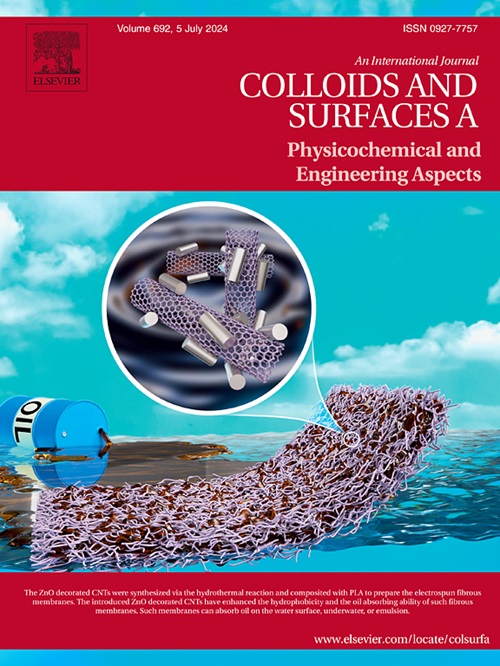Efficient biochar regeneration for a circular economy: Removing emerging contaminants for sustainable water treatment
IF 4.9
2区 化学
Q2 CHEMISTRY, PHYSICAL
Colloids and Surfaces A: Physicochemical and Engineering Aspects
Pub Date : 2024-11-06
DOI:10.1016/j.colsurfa.2024.135730
引用次数: 0
Abstract
Biochar is widely known as a highly effective adsorbent for water treatment, capable of removing a wide range of pollutants. However, its saturation point limits its long-term use, but regeneration can extend its applicability. This study aims to develop a sustainable method for removing pollutants from water that aligns with the concept of the circular economy. Biochar derived from forest residue was used to remove emerging pollutants such as fipronil (FIP), venlafaxine (VEN), sulfamethoxazole (SMX) and trimethoprim (TRM). A comparative analysis of the adsorption of the studied pollutants onto biochar was performed by analyzing the kinetics, where it was found that SMX exhibited the lowest adsorption efficiency, prompting further optimization experiments. Under optimal conditions, adsorption isotherms were used to investigate the pollutant removal mechanisms. The results showed that biochar exhibited high adsorption capacities for FIP, VEN, SMX and TRM, which were 3.77, 2.09, 2.71 and 3.88 mg/g, respectively. Regeneration treatments were applied to remove adsorbed contaminants after biochar saturation. Among them, heat-activated persulfate showed the most effective regeneration, maintaining biochar's adsorption capacity after five cycles with no significant loss. Eventual morphological, structural and chemical alterations post-regeneration were assessed using different characterization techniques. The findings of this research highlight the potential of biochar for sustainable water treatment, supporting the circular economy by extending its life cycle through effective regeneration.
高效生物炭再生,促进循环经济:去除新出现的污染物,实现可持续水处理
众所周知,生物炭是一种高效的水处理吸附剂,能够去除多种污染物。然而,生物炭的饱和点限制了它的长期使用,但再生可以扩大其适用范围。本研究旨在开发一种符合循环经济理念的可持续方法,用于去除水中的污染物。从森林残渣中提取的生物炭被用来去除新出现的污染物,如氟虫腈(FIP)、文拉法辛(VEN)、磺胺甲噁唑(SMX)和三甲氧苄啶(TRM)。通过分析动力学,对所研究的污染物在生物炭上的吸附情况进行了比较分析,发现 SMX 的吸附效率最低,这促使进行进一步的优化实验。在最佳条件下,利用吸附等温线研究污染物的去除机制。结果表明,生物炭对 FIP、VEN、SMX 和 TRM 的吸附容量较高,分别为 3.77、2.09、2.71 和 3.88 mg/g。生物炭饱和后,采用再生处理去除吸附的污染物。其中,热激活过硫酸盐的再生效果最好,经过五个循环后,生物炭的吸附能力保持不变,且没有明显损失。使用不同的表征技术评估了再生后最终的形态、结构和化学变化。这项研究的结果凸显了生物炭在可持续水处理方面的潜力,通过有效再生延长生物炭的生命周期,支持循环经济。
本文章由计算机程序翻译,如有差异,请以英文原文为准。
求助全文
约1分钟内获得全文
求助全文
来源期刊
CiteScore
8.70
自引率
9.60%
发文量
2421
审稿时长
56 days
期刊介绍:
Colloids and Surfaces A: Physicochemical and Engineering Aspects is an international journal devoted to the science underlying applications of colloids and interfacial phenomena.
The journal aims at publishing high quality research papers featuring new materials or new insights into the role of colloid and interface science in (for example) food, energy, minerals processing, pharmaceuticals or the environment.

 求助内容:
求助内容: 应助结果提醒方式:
应助结果提醒方式:


